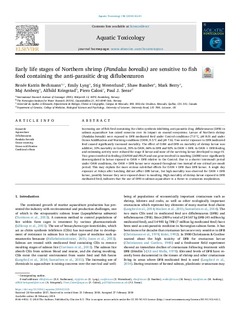| dc.contributor.author | Bechmann, Renée Katrin | |
| dc.contributor.author | Lyng, Emily | |
| dc.contributor.author | Westerlund, Stig | |
| dc.contributor.author | Bamber, Shaw | |
| dc.contributor.author | Berry, Mark | |
| dc.contributor.author | Arnberg, Maj | |
| dc.contributor.author | Kringstad, Alfhild | |
| dc.contributor.author | Calosi, Piero | |
| dc.contributor.author | Seear, Paul J. | |
| dc.date.accessioned | 2019-01-23T08:05:04Z | |
| dc.date.available | 2019-01-23T08:05:04Z | |
| dc.date.created | 2018-07-09T09:30:50Z | |
| dc.date.issued | 2018 | |
| dc.identifier.citation | Aquatic Toxicology. 2018, 198, 82-91. | nb_NO |
| dc.identifier.issn | 0166-445X | |
| dc.identifier.uri | http://hdl.handle.net/11250/2581868 | |
| dc.description.abstract | Increasing use of fish feed containing the chitin synthesis inhibiting anti-parasitic drug diflubenzuron (DFB) in salmon aquaculture has raised concerns over its impact on coastal ecosystems. Larvae of Northern shrimp (Pandalus borealis) were exposed to DFB medicated feed under Control conditions (7.0 °C, pH 8.0) and under Ocean Acidification and Warming conditions (OAW, 9.5 °C and pH 7.6). Two weeks’ exposure to DFB medicated feed caused significantly increased mortality. The effect of OAW and DFB on mortality of shrimp larvae was additive; 10% mortality in Control, 35% in OAW, 66% in DFB and 92% in OAW + DFB. In OAW + DFB feeding and swimming activity were reduced for stage II larvae and none of the surviving larvae developed to stage IV. Two genes involved in feeding (GAPDH and PRLP) and one gene involved in moulting (DD9B) were significantly downregulated in larvae exposed to OAW + DFB relative to the Control. Due to a shorter intermoult period under OAW conditions, the OAW + DFB larvae were exposed throughout two instead of one critical pre-moult period. This may explain the more serious sub-lethal effects for OAW + DFB than DFB larvae. A single day exposure at 4 days after hatching did not affect DFB larvae, but high mortality was observed for OAW + DFB larvae, possibly because they were exposed closer to moulting. High mortality of shrimp larvae exposed to DFB medicated feed, indicates that the use of DFB in salmon aquaculture is a threat to crustacean zooplankton. | nb_NO |
| dc.language.iso | eng | nb_NO |
| dc.publisher | Elsevier | nb_NO |
| dc.rights | Attribution-NonCommercial-NoDerivatives 4.0 Internasjonal | * |
| dc.rights.uri | http://creativecommons.org/licenses/by-nc-nd/4.0/deed.no | * |
| dc.title | Early life stages of Northern shrimp (Pandalus borealis) are sensitive to fish feed containing the anti-parasitic drug diflubenzuron | nb_NO |
| dc.type | Journal article | nb_NO |
| dc.type | Peer reviewed | nb_NO |
| dc.description.version | publishedVersion | nb_NO |
| dc.rights.holder | © 2018 The Authors | nb_NO |
| dc.source.pagenumber | 82-91 | nb_NO |
| dc.source.volume | 198 | nb_NO |
| dc.source.journal | Aquatic Toxicology | nb_NO |
| dc.identifier.doi | 10.1016/j.aquatox.2018.02.021 | |
| dc.identifier.cristin | 1596296 | |
| dc.relation.project | Norges forskningsråd: 234407 | nb_NO |
| cristin.unitcode | 7464,30,21,0 | |
| cristin.unitname | Miljøkjemi | |
| cristin.ispublished | true | |
| cristin.fulltext | original | |
| cristin.qualitycode | 2 | |

